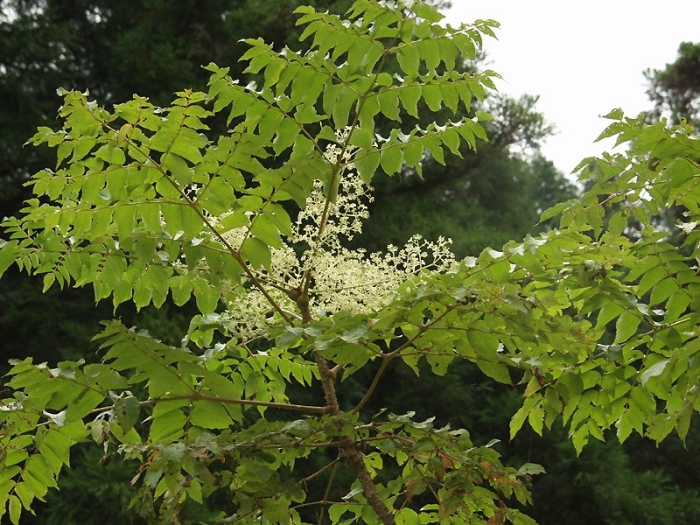Japanese Angelica Tree
(Aralia elata)
Japanese Angelica Tree (Aralia elata)
/
/

‘Uncle Carl’ (カールおじさん).
CC BY-SA 3.0
Image By:
‘Uncle Carl’ (カールおじさん).
Recorded By:
Copyright:
CC BY-SA 3.0
Copyright Notice:
Photo by: ‘Uncle Carl’ (カールおじさん). | License Type: CC BY-SA 3.0 | License URL: http://creativecommons.org/licenses/by-sa/3.0/ | Uploader: Pixeltoo | Publisher: Wikimedia Commons | Title: Aralia_elata_en_fleur4081.jpg | Notes: Copied from German Wikipedia. Originally uploaded as [[:de:Bild:Araukarienrinde_gross.jpg]] to German Wikipedia by user [[:de:User:Gan]] 22:01. |












































































Estimated Native Range
Summary
Aralia elata, commonly known as Japanese Angelica Tree, is a deciduous tree native to the understory of temperate forests in East Asia, including Korea, Japan, and parts of China. It can grow up to 10 m (33 ft) in height and is notable for its rough, gray bark with prickles and large, double pinnate leaves that can reach 60–120 cm in length. The tree produces showy umbels of small, white flowers in late summer, followed by small black drupes that are attractive to birds. The foliage turns yellow in the fall, adding seasonal interest.
Japanese Angelica Tree is valued for its exotic appearance and is often used in ornamental plantings, urban landscapes, and as a focal point in gardens. It is tolerant of a range of soil conditions but prefers deep, loamy soils. While it can grow in full sun, it thrives in partial shade, which more closely mimics its native understory habitat. The cultivars ’Variegata’ and ’Aureovariegata’ have been recognized for their variegated foliage with the Royal Horticultural Society’s Award of Garden Merit. Gardeners should be aware that Aralia elata requires medium amounts of water and well-drained soil. It can be potentially invasive when grown outside its native range, so it is important to consult local guidelines before planting.
The species has been noted for its potential invasiveness in some regions, including the United States, where it can outcompete native flora.CC BY-SA 4.0
Japanese Angelica Tree is valued for its exotic appearance and is often used in ornamental plantings, urban landscapes, and as a focal point in gardens. It is tolerant of a range of soil conditions but prefers deep, loamy soils. While it can grow in full sun, it thrives in partial shade, which more closely mimics its native understory habitat. The cultivars ’Variegata’ and ’Aureovariegata’ have been recognized for their variegated foliage with the Royal Horticultural Society’s Award of Garden Merit. Gardeners should be aware that Aralia elata requires medium amounts of water and well-drained soil. It can be potentially invasive when grown outside its native range, so it is important to consult local guidelines before planting.
The species has been noted for its potential invasiveness in some regions, including the United States, where it can outcompete native flora.CC BY-SA 4.0
Plant Description
- Plant Type: Tree
- Height: 12-18 feet
- Width: 6-10 feet
- Growth Rate: Moderate
- Flower Color: Cream, White
- Flowering Season: Summer
- Leaf Retention: Deciduous
Growth Requirements
- Sun: Full Sun, Part Shade
- Water: Medium
- Drainage: Medium
Common Uses
Bee Garden, Bird Garden, Border Plant, Butterfly Garden, Deer Resistant, Drought Tolerant, Edible*Disclaimer: Easyscape's listed plant edibility is for informational use. Always verify the safety and proper identification of any plant before consumption.
Natural Habitat
Temperate forest understories in East Asia
Other Names
Common Names: Hercules’ Club, Japanese Angelica-Tree, Korean Angelica-Tree, Japanese Aralia, Angélique Du Japon, Aralia Élevé, Aralie Élevée, Duivelswandelstok, Kinesisk Parkaralia, Parkaralia, 두릅나무
Scientific Names: , Aralia elata, Aralia chinensis var. elata, Aralia spinosa var. elata, Dimorphanthus elatus,
GBIF Accepted Name: Aralia elata (Miq.) Seem.